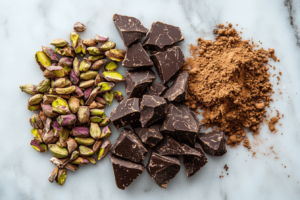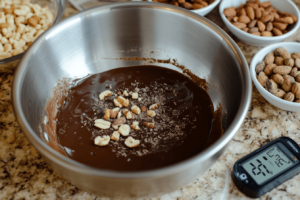Dubai is well-known for its vibrant food culture, stunning architecture, and opulent delights. Yet one of the most intriguing culinary treasures you can discover there is the famous chocolate bar. This decadent dessert blends high-quality cocoa with unique local flavors to create a sweet treat that is both indulgent and full of character. Above all, it offers a taste of pure luxury. Indeed, many people around the world crave it for its exotic twist and impressive presentation.
In this article, we will explore how to make an authentic Dubai chocolate bar recipe at home. We will also look at some essential tips, variations, and professional techniques that will help you craft a dessert worthy of the emirates. Whether you are a passionate baker or simply a curious foodie, this guide will give you all you need to create a mouthwatering Middle Eastern chocolate treat. Furthermore, you will gain insights into how local ingredients and spices transform traditional chocolate into a memorable dessert. So, keep reading and prepare to indulge in sweet luxury.
Why Dubai’s Chocolate Bar Is So Special
Dubai’s chocolate bar stands out because of its unique fusion of local and international elements. Typically, chocolate bars come in many varieties, yet the Middle Eastern spin elevates them with spices, floral notes, and unexpected flavor combinations. More importantly, high-quality cocoa often meets premium ingredients like saffron, pistachios, and even camel milk powder. Consequently, the result is a treat that feels both familiar and adventurous.
Moreover, Dubai is known for its lavish lifestyle. Hence, sweet confections from this city sometimes include edible gold leaf or precious packaging. However, even when made at home, you can still capture that elegant essence. By mindfully choosing your ingredients, you can replicate the flavors and textures that make these bars delightful. In short, the blend of Middle Eastern influences with a global chocolate tradition makes the Dubai chocolate bar recipe a highlight among dessert lovers.
Selecting the Best Ingredients for a Dubai Chocolate Bar Recipe
You can make a memorable Dubai chocolate bar with a few high-quality ingredients. However, the specific combinations you choose will define the aroma, texture, and overall taste of your creation. Here are some key ingredients that bring authenticity to your dessert:

Premium Cocoa or Couverture Chocolate
First and foremost, choose the best cocoa or couverture chocolate you can find. Couverture chocolate contains a higher amount of cocoa butter. Therefore, it offers a smoother texture and more intense flavor. In fact, many professional chocolatiers use couverture for molding bars because it melts evenly and sets with a glossy finish. If you can source chocolate from the Middle East, it might also offer a more authentic feel. Still, you can use any high-end brand of dark, milk, or semisweet chocolate to achieve excellent results.
Camel Milk Powder
Camel milk is a prized ingredient in certain parts of the Middle East. It is often praised for its mild flavor, high nutritional value, and cultural significance. Although fresh camel milk might be challenging to find outside the UAE, camel milk powder has become more accessible online. Adding a small amount of this powder to your chocolate mixture can provide a subtle yet distinctive taste. While it might seem like a novelty, camel milk powder truly captures the spirit of an authentic Emirati chocolate bar.
Spices and Flavorings
Spices are crucial in Middle Eastern cuisine. Therefore, when crafting a Dubai chocolate bar recipe, consider adding ground cardamom, saffron threads, or rosewater. These flavor enhancers give your bars an aromatic dimension that sets them apart from conventional chocolate confections. For instance, a pinch of saffron imparts a delicate, exotic taste, while rosewater adds a floral twist. Nevertheless, be cautious with the quantities because a little goes a long way.
Crunchy Add-Ins
Texture plays a vital role in a chocolate bar’s enjoyment. Consequently, including crunchy elements can elevate your homemade bars. Popular options in Dubai-inspired chocolates often include chopped pistachios, roasted almonds, or hazelnuts. Pistachios are especially common in Middle Eastern desserts. They offer a brilliant pop of color and a mildly sweet flavor. You may also experiment with sesame seeds, candied ginger, or dried fruit if you like a bit of variety.
Edible Gold Leaf or Decorative Touches
While not essential, adding a gold leaf accent can give your finished chocolate bars a regal flair. Dubai’s culture places emphasis on grandeur and luxury. Thus, a simple decorative detail can echo the city’s flamboyant style. Alternatively, you can drizzle extra chocolate or sprinkle sea salt over the bars to enhance their visual appeal and flavor.
Essential Equipment for Making a Dubai Chocolate Bar Recipe
Having the right tools makes a noticeable difference in the final quality of your chocolate bars. You do not need a full professional chocolate kitchen, but some basic items are helpful:
- Chocolate thermometer: Melted chocolate is sensitive to temperature changes. A thermometer helps you maintain the ideal range for tempering.
- Silicone or polycarbonate molds: These molds give your bars a uniform shape and a polished appearance.
- Double boiler or microwave-safe bowl: Gentle heating is key when melting chocolate. A double boiler or microwave ensures you do not scorch the cocoa.
- Kitchen scale: Precise measurements lead to consistent results, especially when dealing with chocolate.
- Rubber spatula: Use this to stir melted chocolate smoothly and scrape down the sides of your bowl.
By choosing quality equipment, you ensure your bars will set properly and have a professional-looking finish. Indeed, careful attention to temperature, texture, and time can make your homemade treats seem straight from a high-end chocolatier in Dubai.
Step-by-Step Guide to Creating Your Dubai Chocolate Bar Recipe
Below is a concise method to make your own Dubai chocolate bar. Follow these steps for a flavor-packed result that brings Middle Eastern charm to your dessert table.
1. Prepare Your Workspace
Begin by cleaning your kitchen area. Organize your molds, thermometer, and ingredients. This ensures a smooth workflow. Moreover, it helps you avoid rushing to find items while the chocolate is melting.
2. Chop the Chocolate
Use a sharp knife to chop your chocolate into small, even pieces. This step allows quicker, more uniform melting. It might seem time-consuming, but it ensures a velvety texture. Furthermore, it prevents accidental burning.
3. Start Melting
Place two-thirds of the chopped chocolate in a microwave-safe bowl. Heat it in short bursts of 15-20 seconds on medium power. Stir in between each interval. Or, set up a double boiler by placing the bowl over a pot of simmering water. Keep the water at a gentle simmer. Direct heat can scorch your chocolate. Therefore, constant observation is crucial.
4. Monitor Temperature
Once the chocolate reaches around 110°F (43°C), remove it from the heat source. Stir the mixture to ensure even melting. Next, add the remaining one-third of the chopped chocolate. Gently stir it in to help cool the mixture to about 84°F (29°C). Then, reheat it carefully to around 88-90°F (31-32°C) for dark chocolate or about 86-88°F (30-31°C) if using milk or white chocolate. This process is called tempering. It ensures a shiny finish and crisp snap.

5. Add Camel Milk Powder and Spices
With the chocolate at the ideal temperature, sprinkle in a small amount of camel milk powder. For example, start with half a teaspoon per 8 ounces of chocolate. Add more if you want a stronger taste. Then, stir in a pinch of cardamom or saffron. If using rosewater, add just a drop or two. Too much can overpower the chocolate. In addition, stir gently but thoroughly to disperse flavors evenly.
6. Incorporate Crunchy Elements
Fold in your chosen nuts or seeds. Pistachios are a favorite for adding color and taste. Almonds or hazelnuts also pair well with chocolate. Keep the quantity moderate. You do not want to overshadow the chocolate flavor. However, you still want a pleasant crunch. For instance, a quarter cup of chopped nuts per 8 ounces of chocolate is a good starting ratio.
7. Pour into Molds
Pour the chocolate mixture into clean, dry molds. Tap the molds lightly on the counter. This action releases air bubbles. Also, use a spatula to smooth the surface. If you want a swirl of white or milk chocolate in your bar, now is the time to drizzle it over the top and swirl with a toothpick.
8. Set and Decorate
Allow the chocolate to set at room temperature for about 15 minutes. Then, place the molds in the refrigerator for an additional 15-20 minutes. Once the bars are firm, gently pop them out of the molds. If desired, apply decorative touches like edible gold leaf, a drizzle of contrasting chocolate, or a sprinkle of sea salt.
Flavor Variations for the Dubai Chocolate Bar Recipe
You can personalize your Dubai chocolate bar recipe by experimenting with different flavor elements. Below are some variations that highlight both Middle Eastern and global influences:
Middle Eastern Coffee Infusion
Arabic coffee (also known as Gahwa) is a symbol of hospitality in the region. It includes spices like cardamom and sometimes saffron. Dissolve instant Arabic coffee granules or finely ground coffee in a small amount of warm milk. Then, blend it into your tempered chocolate. The result is a subtle coffee note that complements the sweetness of the bar.
Date Caramel Filling
Dates are synonymous with Middle Eastern culture. To create a date caramel, blend soaked dates with a bit of cream, a touch of butter, and a dash of salt until smooth. Layer this mixture in the center of your bar. Therefore, when someone bites into the chocolate, they will discover a soft, sweet filling that nods to classic Emirati desserts.
Rose-Pistachio Delight
Rosewater and pistachios already appear in many Middle Eastern confections. Emphasize their union by stirring a teaspoon of rosewater into the chocolate and topping the bars with a generous sprinkle of crushed pistachios. In addition, garnish with dried rose petals for a more floral accent.
Spiced White Chocolate
Dark chocolate is commonly used in many recipes, but white chocolate also has its charm. Enhance its sweetness with ground cinnamon and a small amount of crushed fennel seeds. The slight spice balances the otherwise very sweet profile of white chocolate and brings a new dimension to your dessert.
Tips for Perfect Tempering and Texture
Tempering might seem intimidating, yet with a bit of practice, it becomes second nature. Here are some helpful hints:
- Measure temperatures accurately: Chocolate is sensitive. Small deviations can make it dull or grainy.
- Stir often: This distributes heat evenly and avoids hot spots.
- Be patient: Rushing through the tempering process often leads to imperfect results.
- Work with small batches: Tempering becomes easier to control when dealing with a moderate amount of chocolate.
Achieving a balanced texture involves more than just the chocolate. Indeed, the crunch from nuts, the creaminess of camel milk powder, and the floral hints of spices all come together to create a harmonious bite. Therefore, start with the basic recipe and adjust elements to suit your palate.
Serving and Storing Your Dubai Chocolate Bar Recipe
Once you have prepared and molded your bars, store them in a cool, dry place. Avoid direct sunlight and high humidity, as these conditions can cause the chocolate to bloom, creating white streaks on the surface. In most climates, a pantry cupboard is fine. If you live in a hot area, you might need to keep them in the refrigerator, but be sure to wrap the bars properly to prevent moisture absorption.
When serving, cut your chocolate bar into smaller pieces to show off any decorative layers inside. Placing the bars on a dessert platter alongside fresh fruits like strawberries or figs also highlights their rich flavor. Moreover, pairing the bars with Arabic coffee or mint tea can enhance their Middle Eastern theme.
If you plan to give these bars as gifts, package them in decorative boxes. Add a luxurious ribbon or a small note describing the unique flavors. Friends and family will certainly appreciate the personal touch and cultural flair.

Frequently Asked Questions
What is Dubai chocolate bar made of?
It often includes high-quality cocoa and unique local ingredients. Common additions are spices like cardamom, saffron, or even camel milk powder. This special blend creates a distinct taste you won’t find in standard chocolate bars.
How to get famous Dubai chocolate?
You can buy it online, in specialty shops, or in gourmet chocolate boutiques in Dubai. Some global retailers also carry luxury Middle Eastern brands. If you prefer homemade, you can follow a traditional recipe that incorporates authentic spices and premium cocoa.
What are the steps of making a chocolate bar?
You need to melt and temper your chocolate, then add flavorings or crunchy elements. Next, you pour the mixture into molds. Finally, let it set. When done correctly, you get a shiny and firm bar with a rich snap.
Is Dubai chocolate good?
Many people find Dubai chocolate exceptional because it offers both global quality standards and local flavor twists. The infusion of regional spices and camel milk powder often delivers a memorable taste and texture.
Conclusion
Creating a homemade Dubai chocolate bar recipe is simpler than you might think. Yet the results are strikingly delicious and reminiscent of the extravagance that defines the city’s culinary scene. By using premium cocoa, exotic ingredients like camel milk powder, and aromatic spices, you can achieve a bar that feels indulgent. Furthermore, thoughtful additions such as pistachios, rosewater, or saffron can offer layers of flavor and texture. Above all, it’s a sweet way to experience a touch of Middle Eastern charm without leaving your kitchen. Take your time, follow the tempering process, and soon you will have a luxurious treat that sparks the senses and surprises your guests.

